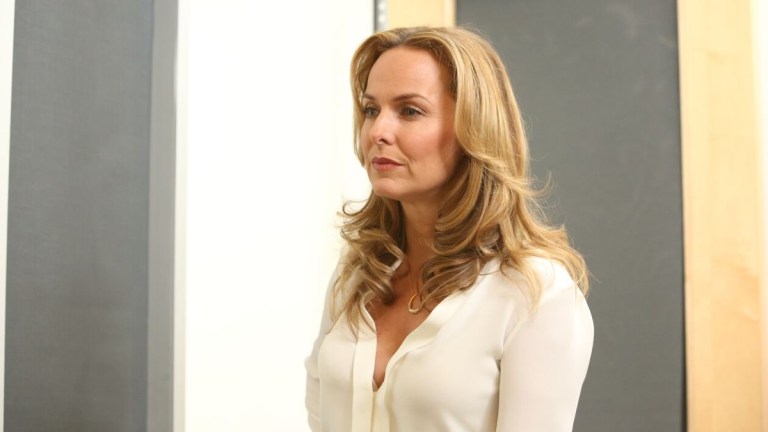Why Jan Levinson Was One of The Office’s Best Creations
Jan Levinson was not only one of The Office’s most polarizing characters, but one of the series’ best.

Whether you’re a fan or not, The Office was and has remained one of the most popular sitcoms in TV history. The mockumentary followed the day-to-day events and misadventures of the daily lives of employees at Dunder Mifflin Paper Company in Scranton, Pennsylvania. It introduced audiences to characters many know and love still today, like Michael Scott (Steve Carell), Pam Beesly (Jenna Fischer), as well as some that were more polarizing, like Jan Levinson (Melora Hardin).
Introduced in the series’ pilot episode as Jan Levinson-Gould, she is Vice President of Sales at Dunder Mifflin and Michael’s superior. Because the two have closely-related jobs, after she gets divorced, they eventually start a relationship, which becomes a source of much comedy throughout the series, largely because of their contrasting personalities. But there’s more to Jan than the surface-based funny bits she contributes.
Sure, Jan can be seen as a hilarious character to watch, but she isn’t funny in that she’s an oblivious jokester like Michael—she’s funny because she’s a standout from him and everyone else in the office. The seriousness she’s initially known for bounces off the others, capitalizing on the awkward and cringe humor the show is associated with. Additionally, audiences find Jan so funny because of her eventual downfall. Her increasingly dramatic and unstable behaviors are largely played out for huge comedic moments in episodes like “Dinner Party,” where her work and home lives collide and the audience can see how unstable she’s really become. Yet, there remains much more depth and nuance to her.
Melora Hardin, who portrayed Jan, spoke to how misunderstood Jan was as a character and how much she loved playing her in an interview with TODAY.
“She’s so fun mostly because she’s so complicated,” Hardin said. “She has so many different layers to her personality and to her hopes and dreams and fears. So she was to me a very multidimensional character and I just loved her. I always loved her and I really hate when people walk up to me and say ‘Jan’s such a bitch.’ I’m like, ‘Clearly you weren’t watching because she’s so much more than that.’ I mean she has her moments for sure, but anyways, I think she’s really complicated and super funny, and I loved playing her.”
Jan starts off as a no-nonsense character—a composed and career-driven executive. She’s obviously quite different from Michael, who is an unserious and eccentric presence. When she’s introduced, there’s a new air in the office because her persona heavily contrasts Michael’s. And because of her demeanor, her co-workers call her names like “Ice Queen” and she receives much gendered scrutiny in her workplace, even from the other women in the Scranton office.
So with everyone against her, plus the fact that she’s in a dysfunctional relationship with the office clown, it’s no surprise Jan soon falters significantly, becoming unhinged and self-destructive, eventually leading to her termination from Dunder Mifflin. She’s definitely pushed past her limits and becomes just as, if not more, toxic as her environment. Based on this downfall, Jan is often seen as crazy and known for her spiraling.
But an important aspect of Jan’s arc is overlooked in her demise: she is a victim of a toxic work environment—more specifically, she’s a female executive facing misogyny from every angle, while having to balance her already-dysfunctional personal and workplace lives. Jan’s not a one-dimensional crazy person, but a complex character who’s not immune to her surroundings. This isn’t to say she is justified in her consequent actions and behavior, but it’s hard to fully blame her when no one was on her side. Plus, it makes it even worse when her peers and significant other never faced any real backlash or effects for their unsolicited jeering and daily inappropriate behavior.
In addition to the negativity in her life caused by Dunder Mifflin, Jan faced other troubles throughout her lifetime that likely contributed to her ultimate downward spiral: she went through a divorce right before dating Michael, she was a victim of identity theft, she doesn’t have many friends, her family no longer talks to her “on advice of counsel,” and in a deleted scene from the episode “Dinner Party,” it’s indicated she had an unhappy childhood and ran away from home. Additionally, although she seeks help from a psychiatrist—which is commendable and shows she’s aware of her state and actively seeking help—they definitely were an unqualified one, supposedly giving bad advice, like telling her to embrace her self-destructive tendencies.
Jan’s story exhibits a word of caution of what an unhealthy environment and having no support system can lead to. Maybe she wouldn’t have turned out that way if she at least got better basic respect from her peers or could’ve gotten proper support to help her navigate her troubles. These misunderstood aspects go to show that there is much more depth and messaging to Jan’s character than her surface-based “crazy” and comedic elements.
Further, Jan has other aspects and achievements in her character and storyline outside of her “crazy” persona worth mentioning: she starts a candle business, she becomes a single mom, and she works for a hospital and later the White Pages phone book company. These go to show qualities like her ambition, independence, and discipline. So although she’s never properly redeemed and her trauma remains largely unchecked, she’s able to get some control of her life, after leaving Dunder Mifflin and later breaking up with Michael.
Despite Jan remaining a polarizing character, her nuances make her one of The Office’s best creations. She’s misunderstood and more than the one-dimensional, cold-hearted wench that her peers view her as, and the depth of character goes beyond a simple fall into frenzy. She’s surely funny to watch. She’s also a multi-dimensional, realistic example of someone having to grapple with the effects of a variety of detrimental life circumstances.
